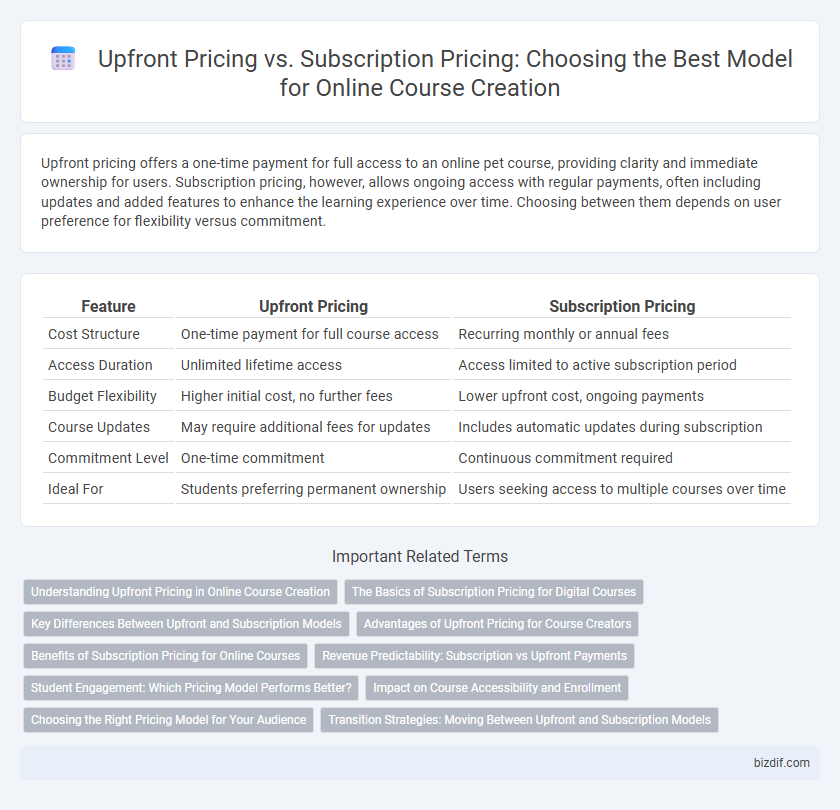Upfront pricing offers a one-time payment for full access to an online pet course, providing clarity and immediate ownership for users. Subscription pricing, however, allows ongoing access with regular payments, often including updates and added features to enhance the learning experience over time. Choosing between them depends on user preference for flexibility versus commitment.
Table of Comparison
| Feature | Upfront Pricing | Subscription Pricing |
|---|---|---|
| Cost Structure | One-time payment for full course access | Recurring monthly or annual fees |
| Access Duration | Unlimited lifetime access | Access limited to active subscription period |
| Budget Flexibility | Higher initial cost, no further fees | Lower upfront cost, ongoing payments |
| Course Updates | May require additional fees for updates | Includes automatic updates during subscription |
| Commitment Level | One-time commitment | Continuous commitment required |
| Ideal For | Students preferring permanent ownership | Users seeking access to multiple courses over time |
Understanding Upfront Pricing in Online Course Creation
Upfront pricing in online course creation involves charging a one-time fee for full course access, enabling clear revenue prediction and immediate cash flow. This model appeals to learners who prefer to avoid recurring charges and want lifetime access to course materials. Understanding upfront pricing helps creators set competitive prices based on course value, market demand, and target audience willingness to pay.
The Basics of Subscription Pricing for Digital Courses
Subscription pricing for digital courses offers ongoing access for a recurring fee, allowing learners to engage with updated content and exclusive resources continuously. This model provides predictable revenue for course creators and encourages long-term student commitment through steady value delivery. Unlike upfront pricing, subscription plans reduce entry barriers by spreading costs over time, enhancing affordability and accessibility.
Key Differences Between Upfront and Subscription Models
Upfront pricing requires customers to pay a one-time fee for lifetime access to an online course, offering clear ownership and no recurring charges. Subscription pricing involves continuous payments, usually monthly or annually, providing ongoing access to course content and regular updates. Key differences include cash flow predictability for creators, customer commitment duration, and flexibility in content delivery and updates.
Advantages of Upfront Pricing for Course Creators
Upfront pricing for online courses provides course creators with immediate revenue, improving cash flow and enabling reinvestment into content development and marketing. This model simplifies financial planning by delivering predictable income without the uncertainty of subscriber retention rates. Furthermore, upfront payments often increase perceived course value, enhancing commitment and reducing drop-off rates among students.
Benefits of Subscription Pricing for Online Courses
Subscription pricing for online courses offers consistent, predictable revenue streams while enhancing customer lifetime value through ongoing access. Learners benefit from flexible learning schedules and continuous content updates, fostering higher engagement and course completion rates. This model supports scalable growth and simplifies budget planning for both creators and students.
Revenue Predictability: Subscription vs Upfront Payments
Subscription pricing enhances revenue predictability by providing a steady, recurring income stream that allows online course creators to forecast earnings more accurately and manage cash flow efficiently. Upfront payments offer immediate revenue but introduce variability, making it challenging to sustain consistent income over time. Implementing subscription models supports long-term financial stability and customer retention, critical for scaling online education businesses.
Student Engagement: Which Pricing Model Performs Better?
Upfront pricing often encourages higher initial student commitment, leading to increased course completion rates and active participation. Subscription pricing fosters continuous engagement by providing access to multiple courses and content updates, which can sustain motivation and long-term learning habits. Data shows subscription models generally yield better retention and ongoing interaction, while upfront pricing maximizes initial enrollment quality.
Impact on Course Accessibility and Enrollment
Upfront pricing for online courses often limits accessibility as the higher initial cost can deter many potential learners, reducing overall enrollment rates. Subscription pricing lowers the financial barrier by spreading payment over time, encouraging more students to enroll and complete multiple courses. This model enhances long-term engagement and broadens access, particularly for price-sensitive audiences seeking continuous learning opportunities.
Choosing the Right Pricing Model for Your Audience
Upfront pricing offers learners one-time payment access to all course materials, appealing to those who prefer owning content outright and avoiding ongoing fees. Subscription pricing provides continuous access with recurring payments, ideal for audiences seeking updated content and flexible learning schedules. Understanding your target audience's preferences and purchasing behaviors is crucial to selecting a pricing model that maximizes engagement and revenue.
Transition Strategies: Moving Between Upfront and Subscription Models
Transitioning between upfront pricing and subscription pricing in online course creation requires clear communication of value changes to existing users. Employing phased pricing adjustments or grandfathering older customers ensures retention and reduces churn. Combining data analytics with customer feedback optimizes the timing and scope of shifts to maintain revenue stability and enhance user experience.
Upfront pricing vs Subscription pricing Infographic

 bizdif.com
bizdif.com